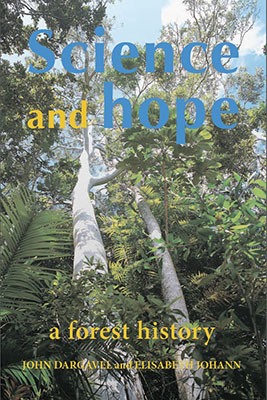Science and Hope
A Forest History

John Dargavel and Elisabeth Johann
A HISTORY OF THE SCIENCE AND IDEAS OF FORESTRY OVER THE PAST THREE CENTURIES

This book tells the story of the hopeful science and trusting art of forestry. It is a story about the hopes of foresters and other scientists to understand the forests more deeply, and about their unspoken trust that their knowledge could ensure an enduring sylvan future. Much has been written on the origins and development of modern forestry in various countries, and on the people and institutions involved, but there is little in the forest history literature that explains what the science actually is. Forest knowledge has an ancient history documented since classical times and applied within the intricate social and legal systems of medieval Europe. This volume is concerned with the modern form of forest science, founded in Europe early in the nineteenth century, when regimes for managing the forests that could be traced to the ancient world and had flourished in the Middle Ages were disrupted. New ways had to be found.
Foresters have tried to know their forests scientifically for over three centuries and have hoped to apply their knowledge to good effect, even though they could not live to see the futures they envisioned. How far did their scientific understanding enable a sylvan future? What, over the three centuries discussed in this book, were their successes and failures? And now what might the future hold for forest science and its application?
This is no tale of triumph: the outlook for the world’s forests is too bleak for that. While many forests are flourishing, the climate is changing, tropical forests are disappearing, others are degrading, species are being lost, governments dither, international conferences fail. This is another, longer story – one of inquiry, of science and persistent endeavour to find a better future for the forests.
LOOK INSIDE THIS BOOK at Amazon.co.uk
‘Science and Hope is a wonderful new book … a comprehensive and eminently readable account of the development of forest science over the past two centuries’.
Tony Bartlett – International Forestry Review
‘Science and Hope is one of those intriguing books that is so well written it can reach a wide range of readers. … A refreshing overview and a compendium of interesting facts. … Highly recommended.’
B.D. Orr – Choice
‘an important book that will be used for years and decades to come … timely, useful and well-conceived’
Brett M. Bennett – Historical Records of Australian Science
‘Australian John Dargavel and Austrian Elisabeth Johann, both widely experienced in forest practice, research, and historiography, present an impressive and valuable ride through 250 years of global scientific forestry.’
Richard Hölzl – H-Net
‘John Dargavel and Elisabeth Johann take the reader on a potentially difficult journey that navigates practically all the world’s trees over at least a few hundred years, and they ensure that the trip is one well worth taking.’
Mark Kuhlberg – Environmental History
THE AUTHORS
Dr John Dargavel is an honorary Visiting Fellow in the Fenner School for Environment and Society at the Australian National University. He worked as a forester in government and industry for over twenty years and has since researched and taught in the areas of forest economics, politics and history. He is the author of more than 70 published papers and book chapters covering forest management, industrial and labour history, trade, forest and environmental politics, and cultural aspects of landscape and remembrance. His book on Australian forest history, Fashioning Australia’s Forests, was published in 1995.
Dr Elisabeth Johann has worked as a forester, has taught forest history at the University of Freiburg and is currently a guest lecturer in the Institute for Socioeconomics, University of Natural Resources and Applied Life Sciences, Vienna. She is a leader in the Austrian Forest Association’s Working Group on Forest History and Deputy Coordinator in IUFRO’s Forest history and traditional knowledge group. She has written papers and book chapters on Austrian forest history, nature-based forestry in Europe, traditional forest knowledge and European spruce forests. Her book on the history of Austrian forests, Österreiches Wald in Verganenheit und Gegenwart, was published in 1983.
CONTENTS
Commencing
FOUNDATION
1. Measuring; 2. Tending; 3. Profiting; 4. Regulating
EXTENSION
5. Introducing; 6. Converting; 7.Conquering
DEVELOPMENT
8. Breeding; 9.Fertilising; 10.Planning
DIVERGENCE
11. Balancing; 12.Excising; 13. Devolving
MILLENNIUM
14. Warming; 15. Sustaining
Considering
Appendices
I. Glossary; II. List of species
Index
Publication date: 1 June 2013, 200pp. Black and white illustrations and diagrams
ISBN 978-1-874267-73-7 (HB) £60
ISBN 978-1-874267-87-4 (PB) £25
